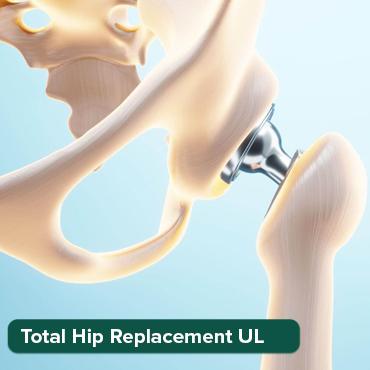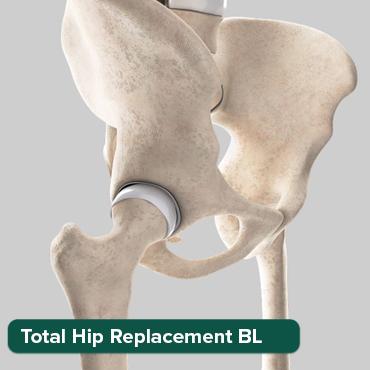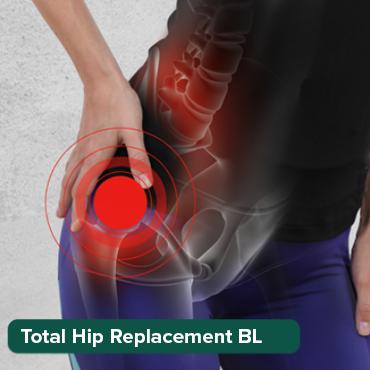
Top Technologies Used in Joint Replacement Across Healthtrip Hospitals
24 Sep, 2025
 Healthtrip
Healthtrip- Robotic-Assisted Joint Replacement: Precision and Minimally Invasive Procedures
- Computer Navigation Systems: Enhancing Accuracy in Joint Alignment
- 3D-Printed Implants: Customization for Optimal Fit and Function
- Advanced Materials in Joint Implants: Longevity and Biocompatibility
- Patient-Specific Instruments (PSI): Tailored Surgical Planning
- Enhanced Post-Operative Rehabilitation Technologies: Accelerating Recovery
- Conclusion
Robotic-Assisted Surgery
Robotic-assisted surgery is rapidly changing the landscape of joint replacement, offering surgeons enhanced precision, improved visualization, and greater control during the procedure. Hospitals within the Healthtrip network, such as Fortis Hospital, Noida, are adopting robotic systems like the MAKOplasty® for knee and hip replacements. This technology utilizes a robotic arm guided by a surgeon, allowing for highly accurate implant placement and alignment. Before the surgery, a 3D model of the patient's joint is created from a CT scan, enabling the surgeon to develop a personalized surgical plan. During the procedure, the robotic arm provides real-time feedback and prevents the surgeon from moving outside the pre-defined boundaries, minimizing the risk of damage to surrounding tissues. This precision can lead to smaller incisions, less blood loss, reduced pain, and faster recovery times for patients. Robotic-assisted surgery is not about replacing the surgeon's skill; it's about augmenting their abilities with advanced technology, ultimately leading to better outcomes and a more comfortable experience for those undergoing joint replacement. With Healthtrip, you can connect with hospitals that offer this advanced technology, ensuring you receive the most innovative and effective care available.
Most popular procedures in India
Advanced Implant Materials and Designs
The success of joint replacement surgery heavily relies on the quality and design of the implants used. Healthtrip partners with hospitals that utilize the latest advancements in implant technology, focusing on materials that are biocompatible, durable, and designed to mimic the natural biomechanics of the joint. For example, at Memorial Bahçelievler Hospital, surgeons may use implants made from materials like titanium alloys, which are known for their strength, corrosion resistance, and ability to integrate with bone. Another exciting development is the use of porous coatings on implants, which encourage bone growth and promote long-term fixation. In terms of design, implants are becoming increasingly customized to fit the individual patient's anatomy, leading to improved stability, range of motion, and a more natural feeling joint. Some hospitals, such as Vejthani Hospital, offer patient-specific implants created using 3D printing technology. These customized implants can provide a more precise fit and reduce the risk of complications. Furthermore, research is ongoing to develop implants that are even more resistant to wear and tear, potentially extending the lifespan of joint replacements. Healthtrip ensures that you have access to hospitals that prioritize the use of cutting-edge implant materials and designs, maximizing the chances of a successful and long-lasting joint replacement.
Minimally Invasive Surgical Techniques
Minimally invasive surgical techniques are revolutionizing joint replacement by reducing the trauma to surrounding tissues, leading to faster recovery times and less post-operative pain. Hospitals within the Healthtrip network are at the forefront of adopting these innovative approaches. At NMC Specialty Hospital, Al Nahda, Dubai, for example, surgeons may utilize smaller incisions and specialized instruments to perform joint replacement procedures. These techniques often involve less muscle cutting and disruption, which can result in reduced blood loss, less scarring, and a quicker return to normal activities. Minimally invasive surgery also allows for shorter hospital stays and a lower risk of complications compared to traditional open surgery. While not all patients are candidates for minimally invasive procedures, the benefits can be significant for those who are eligible. Another advancement is the use of computer navigation systems during surgery, which provide real-time guidance to the surgeon, ensuring accurate implant placement and alignment through smaller incisions. Healthtrip connects you with hospitals that have expertise in minimally invasive joint replacement techniques, offering you the potential for a smoother and more comfortable recovery.
Wellness Treatments
Give yourself the time to relax
Lowest Prices Guaranteed!

Lowest Prices Guaranteed!
Pain Management Strategies
Managing pain effectively after joint replacement surgery is crucial for a successful recovery. Healthtrip-affiliated hospitals prioritize comprehensive pain management strategies that go beyond traditional opioid-based medications. At hospitals such as Saudi German Hospital Cairo, Egypt, multimodal pain management protocols are commonly employed. These protocols involve a combination of different medications, such as non-opioid painkillers, anti-inflammatory drugs, and nerve blocks, to target pain from multiple pathways. This approach can reduce the reliance on opioids, minimizing the risk of side effects such as nausea, constipation, and addiction. Another innovative technique is the use of local anesthetic injections around the surgical site, which can provide long-lasting pain relief in the immediate post-operative period. Furthermore, physical therapy plays a vital role in pain management by promoting circulation, reducing stiffness, and strengthening the muscles around the new joint. Healthtrip recognizes the importance of personalized pain management plans, and we connect you with hospitals that have experienced pain management specialists who will tailor a strategy to your individual needs, ensuring a more comfortable and less painful recovery journey.
Rehabilitation and Physical Therapy
Rehabilitation and physical therapy are integral components of a successful joint replacement recovery. Healthtrip emphasizes the importance of comprehensive rehabilitation programs to help patients regain strength, mobility, and function after surgery. At hospitals like Bangkok Hospital, dedicated physical therapists work closely with patients to develop personalized exercise plans tailored to their individual needs and goals. These plans typically involve a combination of exercises to improve range of motion, strengthen muscles, reduce swelling, and enhance balance. Early mobilization is encouraged to prevent stiffness and promote healing. Patients are also educated on proper body mechanics and techniques to protect their new joint and prevent future injuries. Furthermore, some hospitals offer specialized rehabilitation programs that incorporate advanced technologies such as aquatic therapy and virtual reality to enhance the recovery process. Healthtrip understand that rehabilitation is not a one-size-fits-all approach, and we connect you with hospitals that have experienced physical therapists who will provide ongoing support and guidance throughout your recovery journey, helping you achieve optimal outcomes and regain your independence.
Robotic-Assisted Joint Replacement: Precision and Minimally Invasive Procedures
Imagine undergoing joint replacement surgery with unparalleled precision, less pain, and a faster recovery. Sounds like science fiction, right? Well, it's quickly becoming a reality thanks to robotic-assisted joint replacement! This cutting-edge technology is revolutionizing how orthopedic surgeons perform these procedures, offering a host of benefits for patients seeking relief from chronic joint pain. At Healthtrip, we understand that choosing the right treatment option can feel overwhelming. That's why we're here to break down the complexities of robotic-assisted surgery and help you navigate your journey toward a healthier, more active life. Think of it like having a super-skilled co-pilot assisting your surgeon, providing enhanced visualization, accuracy, and control during the operation. Forget those clunky, invasive procedures of the past; robotic assistance allows for smaller incisions, minimizing tissue damage and blood loss. This translates to less post-operative pain, shorter hospital stays, and a quicker return to your favorite activities. Hospitals like Fortis Memorial Research Institute, Gurgaon and Max Healthcare Saket in India offer advanced robotic joint replacement programs.
The Magic Behind the Machines
So, how does it actually work? Robotic-assisted surgery utilizes a sophisticated robotic arm controlled by your highly skilled surgeon. Before the operation, detailed 3D models of your joint are created using advanced imaging techniques, like CT scans or MRIs. This allows the surgeon to meticulously plan every step of the procedure, considering your unique anatomy and specific needs. During the surgery, the robotic arm acts as an extension of the surgeon's hand, providing enhanced precision and stability. The surgeon guides the robot, using the 3D model as a roadmap, to carefully remove damaged bone and cartilage and precisely position the new joint implant. The robotic system provides real-time feedback and alerts, ensuring that the surgeon stays within the pre-defined boundaries, further minimizing the risk of errors. It's like having a GPS for your surgery, guiding the surgeon with pinpoint accuracy. This is a far cry from traditional methods, which often rely on the surgeon's experience and visual estimation. With robotic assistance, even the most complex joint replacements can be performed with greater accuracy and consistency, potentially leading to improved long-term outcomes. Consider consulting with specialists at hospitals such as Bangkok Hospital in Thailand or Vejthani Hospital, also in Bangkok, to explore your options.
Computer Navigation Systems: Enhancing Accuracy in Joint Alignment
Ever tried assembling flat-pack furniture without the instructions? Frustrating, right? Well, imagine performing a joint replacement without a precise roadmap. That's where computer navigation systems come in! These systems are like the GPS of the operating room, providing surgeons with real-time data and guidance to ensure accurate joint alignment and implant placement. Think of it as having a virtual assistant constantly monitoring the procedure and providing feedback to the surgeon, enhancing their precision and control. This technology is particularly valuable in complex cases where traditional methods may be less accurate. At Healthtrip, we believe that informed patients make the best decisions about their healthcare. Computer navigation systems are designed to minimize the potential for human error and improve the overall success of joint replacement surgeries. It's not about replacing the surgeon's skill and expertise; it's about augmenting their abilities with cutting-edge technology. By providing real-time feedback on joint angles, alignment, and implant position, computer navigation systems help surgeons achieve optimal results, leading to improved patient outcomes and long-term joint function. Hospitals like Fortis Shalimar Bagh in Delhi are increasingly adopting these navigation systems to enhance their joint replacement surgeries.
Navigating Towards Better Alignment
The beauty of computer navigation lies in its ability to personalize the surgical approach. Before the operation, the system creates a virtual model of your joint, taking into account your unique anatomy and biomechanics. During the surgery, sensors are attached to your bones, allowing the computer to track their position and movement in real-time. As the surgeon works, the navigation system provides continuous feedback on the alignment of the joint and the placement of the implant. This allows the surgeon to make precise adjustments as needed, ensuring that the implant is positioned perfectly for optimal function and stability. It’s like having a miniature architect overseeing the construction, guaranteeing that everything is perfectly aligned. The system also helps to minimize the risk of complications, such as dislocation or loosening of the implant. By ensuring accurate alignment, computer navigation can help to reduce wear and tear on the implant, potentially extending its lifespan. Many leading hospitals across the globe, including Memorial Bahçelievler Hospital and Memorial Sisli Hospital in Istanbul, are incorporating computer navigation into their orthopedic programs. Consider exploring these options with Healthtrip.
3D-Printed Implants: Customization for Optimal Fit and Function
Imagine receiving a joint implant that's perfectly tailored to your unique anatomy, like a bespoke suit made just for you. That's the promise of 3D-printed implants! This revolutionary technology is transforming the field of joint replacement, offering the potential for improved fit, function, and longevity. At Healthtrip, we’re excited about the possibilities that 3D printing offers for personalized healthcare. Forget the limitations of off-the-shelf implants; 3D printing allows for the creation of custom-designed implants that perfectly match the patient's bone structure. This means a more secure and stable fit, reducing the risk of complications such as loosening or dislocation. These customized implants are designed using intricate 3D models created from CT scans or MRIs of the patient's joint. The surgeon then works with engineers to fine-tune the design, ensuring that it meets the specific needs of the patient. It's like having a team of artists and engineers collaborating to create a masterpiece for your body. The implant is then "printed" layer by layer using biocompatible materials such as titanium or cobalt-chromium alloys. This process allows for the creation of complex geometries and intricate designs that would be impossible to achieve with traditional manufacturing techniques. The result is a highly customized implant that fits perfectly, providing optimal support and stability. While widespread adoption is still evolving, some pioneering hospitals are starting to offer 3D-printed implant options. Research hospitals like Singapore General Hospital are at the forefront of this technology.
A Perfect Fit, Inside and Out
The benefits of 3D-printed implants extend beyond just a better fit. The ability to create complex geometries allows for the design of implants that promote bone ingrowth, further enhancing stability and long-term fixation. The porous structure of the 3D-printed material allows bone cells to grow into the implant, creating a strong and durable bond. It’s like providing a scaffolding for your bones to regenerate and fuse with the implant. This is particularly beneficial for patients with weakened bones or those undergoing revision surgery. Moreover, 3D printing can also be used to create patient-specific surgical guides, further enhancing the accuracy and precision of the procedure. These guides help the surgeon to position the implant perfectly, minimizing the risk of errors and improving the overall outcome. While the cost of 3D-printed implants can be higher than traditional implants, the potential benefits in terms of improved fit, function, and longevity may make them a worthwhile investment for some patients. As the technology continues to evolve and become more accessible, we can expect to see 3D-printed implants playing an increasingly important role in joint replacement surgery. Keep an eye on centers of excellence in Europe such as Jiménez Díaz Foundation University Hospital in Madrid, Spain, for potential advancements in this field. Healthtrip is committed to keeping you informed about these cutting-edge advancements, helping you make the best decisions for your health and well-being.
Also Read:
Advanced Materials in Joint Implants: Longevity and Biocompatibility
The field of joint replacement has seen a significant leap forward with the introduction of advanced materials, revolutionizing the longevity and biocompatibility of implants. We're not just talking about metal and plastic anymore; we're delving into materials science that sounds like something out of a sci-fi movie! Think about it – these materials are designed to withstand the daily grind of our lives, from climbing stairs to chasing after grandkids, for decades if not longer. The key here is finding the right balance between strength, flexibility, and how well the body accepts the implant. Materials like advanced ceramics, specialized alloys, and highly cross-linked polyethylene are becoming increasingly common. These materials are chosen for their ability to reduce wear and tear, resist corrosion, and minimize the risk of allergic reactions or inflammation. It's like giving your new joint the best possible armor to stand up to the test of time. Hospitals like Fortis Memorial Research Institute, Gurgaon and Max Healthcare Saket in India are at the forefront, utilizing these cutting-edge materials to ensure you get the most out of your joint replacement. At Healthtrip, we connect you with the best hospitals that prioritize these advancements. We believe that investing in high-quality materials is an investment in your long-term well-being and mobility. It's not just about getting a new joint; it's about getting back to living your life to the fullest.
Patient-Specific Instruments (PSI): Tailored Surgical Planning
Imagine getting a suit tailored specifically for you – now imagine that same level of customization applied to your joint replacement surgery. That’s where Patient-Specific Instruments (PSI) come into play! PSI is all about creating surgical tools and guides that are perfectly matched to your unique anatomy. Using advanced imaging techniques like CT scans or MRIs, surgeons can develop a detailed 3D model of your joint. This model then guides the creation of instruments that ensure precise alignment and placement of the implant. Think of it as having a GPS for your surgeon, guiding them with pinpoint accuracy. The benefits of PSI are numerous. By tailoring the surgery to your specific needs, surgeons can minimize the amount of bone removal, reduce the risk of errors, and improve the overall outcome of the procedure. It can also lead to shorter surgery times and reduced recovery periods. Hospitals like OCM Orthopädische Chirurgie München and Vejthani Hospital in Bangkok are incorporating PSI into their joint replacement procedures, offering patients a more personalized and precise surgical experience. Through Healthtrip, we empower patients to access hospitals that utilize PSI, ensuring that their joint replacement is tailored to their individual needs. It's a game-changer in the field, promising better outcomes and a faster return to your favorite activities.
Enhanced Post-Operative Rehabilitation Technologies: Accelerating Recovery
So, you've had your joint replacement surgery – congratulations! But the journey doesn't end there. Post-operative rehabilitation is crucial for regaining strength, mobility, and function. Thankfully, we're no longer limited to just basic exercises and physical therapy. Today, a range of enhanced rehabilitation technologies are helping patients recover faster and more effectively. From robotic-assisted rehabilitation devices that guide your movements to virtual reality programs that make therapy more engaging, the options are vast and exciting. These technologies can help improve range of motion, reduce pain, and build strength in a controlled and progressive manner. Think of it as having a personal trainer who is specifically designed to help you heal! Some hospitals are even using wearable sensors to track your progress and provide personalized feedback, ensuring that you're staying on track with your recovery goals. It’s all about making the rehabilitation process more efficient, enjoyable, and tailored to your individual needs. Facilities like Cleveland Clinic London and Helios Klinikum Erfurt often incorporate these advanced technologies into their rehabilitation programs. At Healthtrip, we understand the importance of comprehensive care, and we connect you with hospitals that prioritize innovative rehabilitation strategies. We believe that a successful joint replacement is not just about the surgery itself, but also about the quality of care you receive afterwards.
Also Read:
Conclusion
The landscape of joint replacement is rapidly evolving, driven by advancements in materials, surgical techniques, and rehabilitation strategies. From robot-assisted surgeries offering unparalleled precision to patient-specific instruments ensuring tailored care, and advanced materials promising longevity, there’s a reason to be optimistic about joint replacement. The goal is not just to replace a worn-out joint, but to restore your quality of life and get you back to doing what you love. Hospitals across the globe like Saudi German Hospital Cairo, Egypt and Bangkok Hospital in Thailand are embracing these innovations to deliver better outcomes for their patients. At Healthtrip, we're committed to keeping you informed about the latest advancements in joint replacement and connecting you with the best healthcare providers worldwide. We believe that everyone deserves access to high-quality, personalized care, and we're here to guide you every step of the way on your journey to better joint health.
Also Read:
Related Blogs

Complete Cost Breakdown of Eye Surgery with Healthtrip
Learn about doctors, hospitals, procedures, and recovery for eye surgery

How to Prepare for Your Eye Surgery in India
Learn about doctors, hospitals, procedures, and recovery for eye surgery

Side Effects and Risk Management of Eye Surgery
Learn about doctors, hospitals, procedures, and recovery for eye surgery

Follow-Up Care for Eye Surgery Patients with Healthtrip Assistance
Learn about doctors, hospitals, procedures, and recovery for eye surgery

Best Hospital Infrastructure for Eye Surgery
Learn about doctors, hospitals, procedures, and recovery for eye surgery

What to Expect During a Eye Surgery Consultation
Learn about doctors, hospitals, procedures, and recovery for eye surgery










